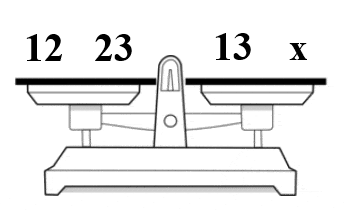Why is algebra so hard? Math experts say it’s because of the big leap students take from the concrete world of arithmetic (2 + 5 = 7) to the abstract world of algebra (2 + 5 = 3 + x – what is x?).
It’s not just the shock of dealing with letters, but also the type of thinking that those letters represent.
Often students are taught algebra as a study of procedures and rules. However, kids forget the rules. So is there another way? The short answer is – yes. We need to help students make sense of the rules and show them how to use a variety of strategies to solve algebraic problems. Here are two such strategies:
- Balance scales
- Bar diagrams
Let’s use an example to show you how these strategies work.
First, the algebra question:
12 + 23 = 13 + x. What is x?
Balance scales
Here’s what that equation looks like on a balance scale.

By visually representing the numbers on two sides of the scales, students can now start to see how the numbers relate to one another to be equal on both sides.
For example, a student may work out that 13 is one more than 12, so x has to be one less than 23. So the answer is 22.
or
13 is 10 less than 23. So that means you need to add 10 to the 12 to even out the balance. So the answer is 22.
Bar diagrams
Here’s what the equation looks like in a bar diagram:

Some students find this kind of visual easier to understand. The total of 13 is a little more than 12, so they need to subtract from13 from 23, and then add that value to 12, to get the value of x.
23 – 13 = 10
12 + 10 = 22

